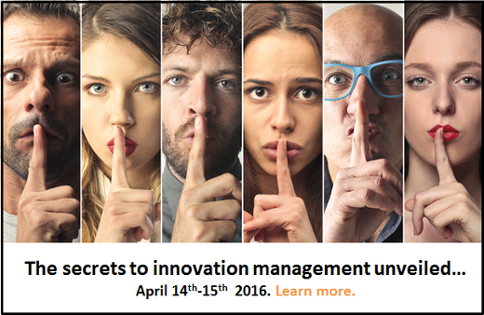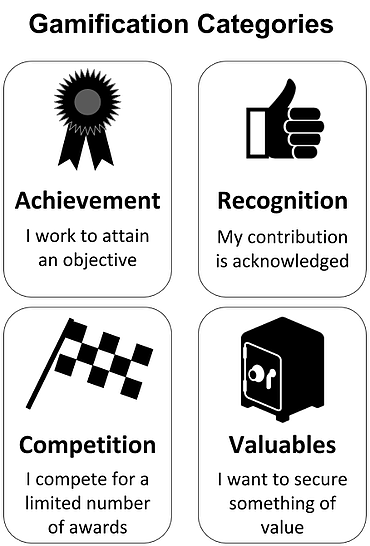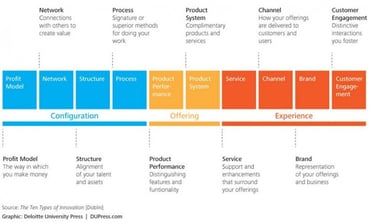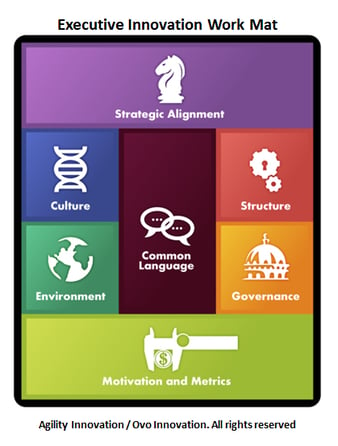
Innovation stands in service to strategic goals such as growing market share, differentiation and disrupting adjacent markets, serving the consistent changing and demanding customer needs by spotting these and then exploiting them rapidly and effectively.
Creating clear goals and linking/aligning innovation to those more agile strategies is a vital role for CEO’s and senior executives. Senior executives must establish the manner in which innovation fits within the strategic context established by goals, vision and strategies. They cannot abdicate this role. Change is hard, so is innovation.
However, even when executives understand the linkage, they may fail to understand how to ensure linkages between corporate strategy and innovation actually does lie with them to be communicated throughout the organization.
When executives simply request innovation and delegate the decisions and definitions to business line leaders or executives outside the boardroom they are delegating the growth and future of the organization to others. They are killing the true potential of innovation as it remains unaligned. This cannot continue, we need to bring innovation into the boardroom as core.
If we are in a world of transient advantage as Rita Gunther McGrath suggests, she clearly states: “Innovation needs to be a continuous, core, well-managed process rather than the episodic and tentative process it is in many companies”.
A different ‘sustaining’ capacity built around innovation as the continuous core, constantly evolving, adapting, learning and adjusting; Innovation In perpetual dynamic motion.
Moving towards a new innovation strategic core
This new innovation core can really only be led and fully integrated from the top, aligned fully into the strategies, organizational design and the goals. In rapidly changing market conditions where advantage is transient then we certainly need very different designs within our organizations to respond. It is absolutely time that innovation comes fully into the board room and driven from the top.
The absolute need is for leadership to lay in the guiding principles for innovation, to make it a more explicit innovation strategy and framework. It does not stop at this alone, it requires a consistent re-enforcing through policy shaping, strategic guidance and the operational documents to support it. Innovation requires on-going leadership engagement.
The strength of the Executive Innovation Work Mat as a framing document to provide this leadership dialogue becomes essential for organizations wanting to gain complete organization engagement.
This integrated framework approach gives a much-needed focus, many of the strategic delivery points, structures and guidance for managing innovation. It becomes the foundational strategic innovation document and equally the communicating mechanism throughout the organization.
The domains we identified as critical to an innovation framework are as follows:
- Aligning innovation to corporate strategy (Strategic Alignment)
- Defining and sustaining an innovation culture (Culture),
- Identifying internal and external innovation environments (Environment),
- Creating a common innovation language, rationale and context (Common Language),
- Designing and developing an innovation structure (Structure),
- Establishing innovation governance (Governance)
- Developing innovation measures and motivation (Motivations and Measures)
While each of these factors in isolation or in different combinations is beneficial, a cohesive strategy focused on developing and engaging all of these competencies does lead to an aligned and engaged innovation framework. From this investigation and our research into innovation best practices, we have identified seven domains which are essential for success. These domains comprise a framework that must be championed by a senior executive or team and constantly reinforced. Innovation will flourish if these domains are in place and mutually reinforcing, and will sputter when one or more of the domains is lacking or absent.
Each of the seven domains is a focal point requiring ‘collective’ attention
Each of these domains is a focal point that plays a vital role for the success of a sustained innovation discipline. When enacted in a concerted fashion they create a compelling innovation environment which sustains innovation activities in all facets of the business, and create clarity and discipline about innovation activities.
Given the breadth of the framework and the strategic nature of the framework, it must be championed by the CEO or a team of senior executives. We believe this innovation “role” – the development and sponsorship of an innovation framework is often overlooked or ignored.
These domains are presented in the Executive Innovation Work Mat
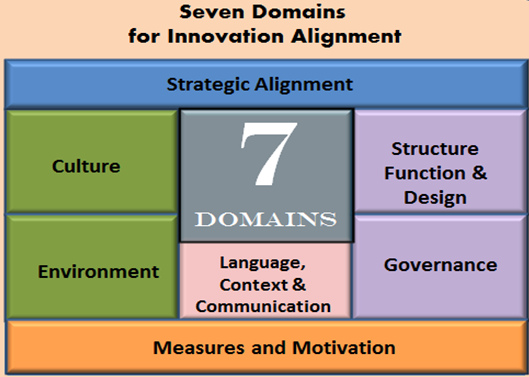
These seven essential domains contribute to a firm’s ability to sustain innovation. They create a consistent innovation framework, work-flow and environment
Defining the innovation path and discussions are grouped around these seven domains
Your innovation teams need a defined innovation roadmap and through this framework they can picture and organize the structuring of their activities, and highlight and identify the needed scope and definition in order to achieve their best results. Our recommended approach – the Executive Work Mat which follows – becomes the organizing mechanism to communicate, align and highlight areas of understanding or required resolution. We introduce the Work Mat and seven essential “domains” that must exist for innovation to take root, and for a framework to evolve which supports and sustains innovation.
Through the Work Mat you as the leader provide the guidance as well as offer the inspiration, context and clarity on how the organization captures the ‘essence’ of the organization's commitment document towards innovation’s essential place within your desire for success. While everyone can innovate, only a committed executive team can establish the structures and frameworks necessary to sustain innovation.
Top Line Call Out Action Points for the Seven Domains
Alignment actions within the Executive Innovation Work mat
Executives must link their innovation goals and outcomes to strategic goals. Executives must clearly state what innovation outcomes they desire, across a spectrum of possibilities (from incremental to disruptive) and what “types” of innovation they prefer or expect (product, service, process, customer experience, business model or all of the above), the ‘how, when and where’. Creating clarity reduces risk and uncertainty for the innovators and ensures a linkage and clearer alignment between corporate strategy and innovation outcomes.
Innovation Structure actions within the Executive Innovation Work mat
Executives must define an innovation “structure” that sustains innovation activity and think through the organizational design for innovation. The structure, form and scale of the innovation function are determined based on innovation strategy, the expected or anticipated results and the breadth and depth of the innovation activity within the business. Creating a defined innovation function complete with processes and scope ensures a much greater likelihood of innovation success. Further, it ensures innovation is not conducted in an ad-hoc, one-off approach that can’t be sustained or repeated.
Common Language, Context, Communication actions within the Executive Innovation Work mat
What you communicate, what you embrace and your level of involvement matter significantly. These actions send signals to the rest of the company. Executives must establish clear goals for innovation, and support those goals with a common innovation language. Where possible, executives must do more than simply talk about innovation, but demonstrate engagement through participation, regular reporting and by recognizing key successes.
Environment actions within the Executive Innovation Work mat
Executives must do more than simply encourage innovation and define an innovation function. They must identify all of the important processes, groups and functions that must be involved to accelerate an idea from concept to commercial product or service and smooth the transitions between the groups and eliminate or reduce barriers and gaps in business silos. Otherwise good ideas will never bridge the gap between idea and product, or won’t find adequate support from enabling and protective teams like IT and regulatory.
Culture actions within the Executive Innovation Work mat
Executives can demonstrate their commitment to innovation by working to change internal attitudes and behaviours. The work mat identifies cultural attributes and characteristics that exist in strong innovators, and helps executives assess their culture and implement programs to change the culture. Corporate culture does not change easily or quickly. Changing the culture will require consistent communication and executive engagement (as described in the section above) as well as changes to prevailing attitudes, behaviours, compensation and rewards.
Innovation Governance actions within the Executive Innovation Work mat
Executives must establish at least the basic frameworks for innovation programs, starting with funding innovation activities in annual planning processes and measuring results based on stated KPIs. The governance of innovation activities must include funding mechanisms, scope definition, appropriate targets and timeframes, measurements, reporting and evaluation metrics. Innovation must be subject to many of the same governance models and methods that are applied to other critical business functions.
Motivations and Measures actions within the Executive Innovation Work mat
Executives must constantly seek new motivation actions and may need to change motivation focus and discipline. Research demonstrates good innovators are motivated in very different ways than other staff. Extrinsic programs must be continued and extended while intrinsic rewards become more important as innovation grows in importance. Executives must define new motivation programs and potentially new roles or career paths.
Combining the seven domains - summary
The Executive Work mat is designed to help assess the strengths and gaps that exist in an organizations innovation management process, and to deliver a formal “workout” methodology for those that recognize that this does provide the essential framing desired to be understood throughout the organization, as essential to building a sustaining set of innovation competencies and capabilities .
Designing a new strategic innovation framework at the top of organizations helps close the many gaps we see today. We need to move from ‘disconnect’ to ‘reconnect’ and make innovation more centrally designed to meet today’s challenges, those that are cross-cutting, engaging and comprehensive, so as to allow innovation that greater freedom and scope to contribute into the growth organization leaders are demanding and those wanting to be involved are looking for.
Related Posts...





